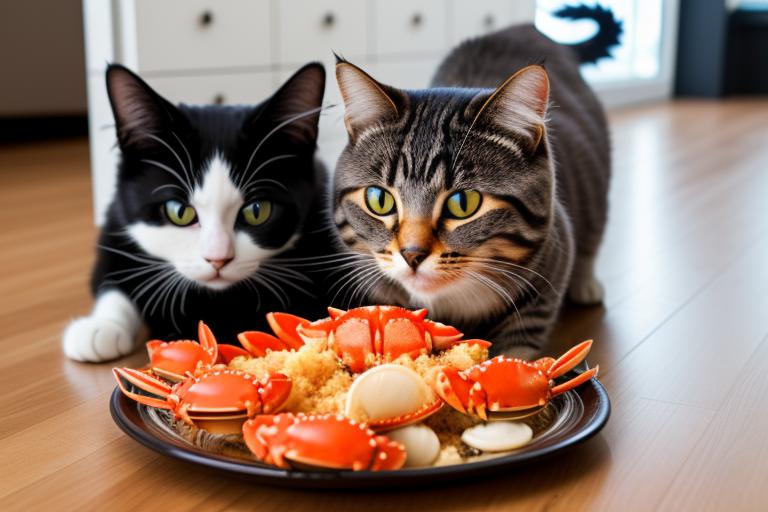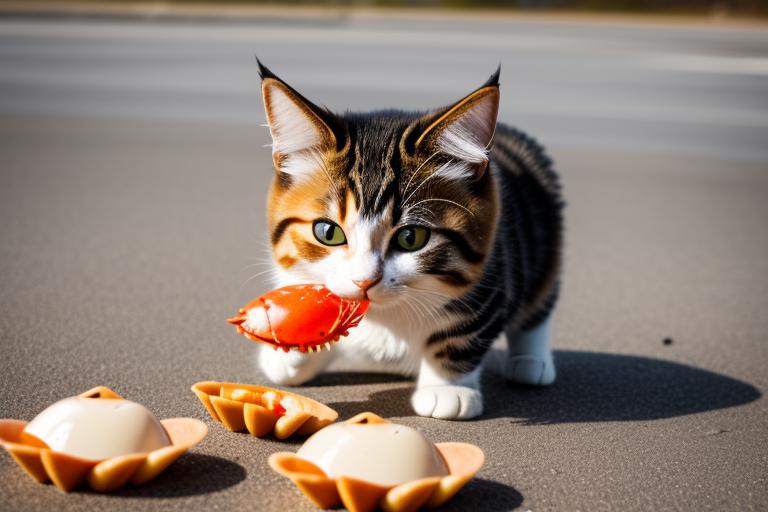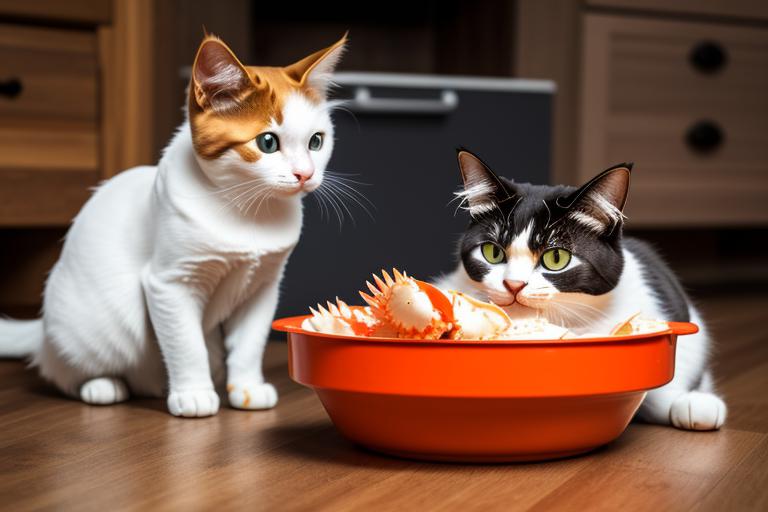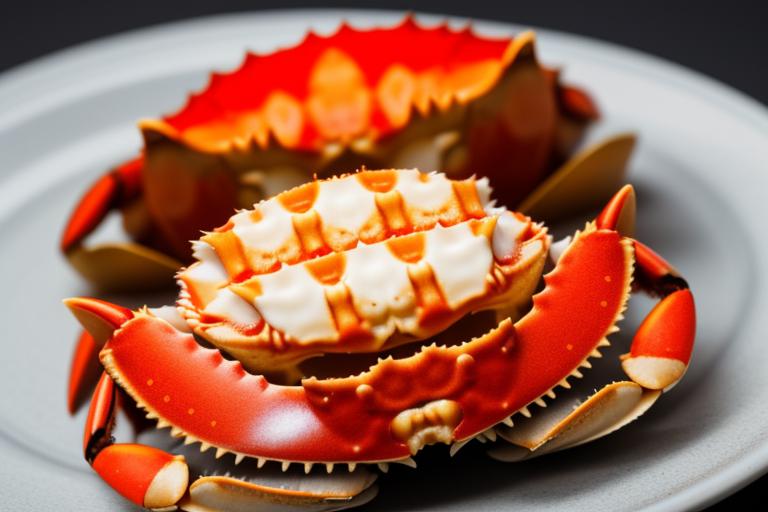Have you ever watched a cat chase after a toy with relentless determination, their eyes focused and their body poised for action? Cats are natural hunters, always seeking out their next prey. So, it’s no wonder that the question of whether cats can eat crab shells arises. After all, the tough exterior of a crab shell may seem like the perfect challenge for our feline friends.
But can they actually consume it? In this discussion, we will explore the nutritional value, potential benefits, and risks associated with cats eating crab shells.
So, let’s uncover the truth and reveal whether cats can truly indulge in this seafood delight.
Nutritional Value of Crab Shells for Cats

Cats don’t derive significant nutritional value from consuming crab shells. While cats are carnivores and their diet mainly consists of meat, crab shells don’t provide the necessary nutrients that cats need to thrive. Crab shells are hard and difficult to digest for cats, who’ve a limited ability to break down tough materials. The main component of crab shells is chitin, a complex carbohydrate that cats can’t efficiently metabolize. This means that even if a cat consumes crab shells, they’ll not receive any substantial nutritional benefit from them.
Additionally, crab shells may pose a potential choking hazard for cats. The sharp edges and rigid structure of the shells can cause injuries to the cat’s digestive system if swallowed whole or in large pieces. It’s important to note that while small amounts of crab meat can be safe for cats to eat, the shells themselves should be avoided.
To ensure that your cat receives the proper nutrition, it’s best to stick to a balanced and complete cat food diet recommended by veterinarians. This will provide all the necessary nutrients in the right proportions to support your cat’s overall health and well-being.
Potential Health Benefits of Crab Shells for Cats

While crab shells don’t provide significant nutritional value for cats, there are potential health benefits that can be derived from them. Although cats primarily require a balanced diet of protein, fat, and carbohydrates, incorporating crab shells into their diet can offer some advantages.
Here are a few potential health benefits:
- Dental Health: Chewing on crab shells can help remove plaque and tartar buildup, promoting good oral hygiene for your feline friend. The abrasive texture of the shells acts as a natural toothbrush, reducing the risk of dental diseases.
- Mineral Intake: Crab shells contain minerals such as calcium and phosphorus, which are essential for maintaining strong bones and teeth in cats. These minerals contribute to overall skeletal health and can be beneficial, especially for growing kittens and older cats with age-related bone issues.
- Digestive Health: The rough texture of crab shells can act as a source of dietary fiber, aiding in digestion and preventing constipation in cats. Fiber helps regulate bowel movements and promotes a healthy gastrointestinal system.
While it’s important to note that crab shells should be given in moderation and only if they’re properly cleaned and cooked, these potential health benefits make them an interesting addition to your cat’s diet. As always, consult with your veterinarian before introducing any new food to your cat’s diet.
Risks and Dangers of Cats Eating Crab Shells

Be cautious when allowing your cat to consume crab shells as there are potential risks and dangers associated with this practice. While it may seem harmless to give your cat the leftover shells from your seafood feast, it’s important to understand the potential hazards involved.
One of the main risks is the possibility of choking or getting the shell stuck in your cat’s throat. Crab shells can be sharp and jagged, posing a significant danger to your cat’s delicate digestive system. Ingesting these shells can cause tears or blockages in the esophagus, stomach, or intestines, leading to severe complications and even requiring surgery.
Additionally, crab shells can contain harmful bacteria and parasites that are harmful to cats. These microorganisms can cause food poisoning or gastrointestinal infections, resulting in vomiting, diarrhea, and dehydration.
It’s crucial to remember that while cats are obligate carnivores, they need a balanced diet that includes essential nutrients found in meat and commercial cat food. Offering your cat crab shells as a treat or supplement isn’t recommended due to the potential risks involved.
How to Safely Prepare Crab Shells for Cats

When it comes to safely preparing crab shells for your cat, it’s important to take certain precautions to minimize any potential risks. While cats can enjoy the taste and texture of crab shells, it’s crucial to ensure they’re prepared in a safe manner. Here’s how you can do it:
- Clean the shells thoroughly: Before giving crab shells to your cat, make sure to clean them properly. Remove any remaining meat or debris and rinse them well with water. This step helps eliminate any harmful bacteria or contaminants that may be present.
- Cook the shells: To further reduce the risk of bacteria, it’s advisable to cook the crab shells before giving them to your cat. Boiling or steaming them for a few minutes will help kill any potential pathogens and make the shells safer for consumption.
- Break the shells into small pieces: Cats have smaller mouths and may struggle to chew large crab shells. To prevent choking or digestive issues, break the shells into smaller, more manageable pieces. This will make it easier for your cat to eat and digest the shells without any problems.
Alternatives to Crab Shells for Cats’ Dietary Needs
Consider other options for meeting your cat’s dietary needs instead of relying solely on crab shells. While crab shells may provide some nutritional benefits, it’s important to provide a balanced and varied diet for your feline friend.
One alternative to crab shells is to offer your cat commercially prepared cat food that’s specifically formulated to meet their nutritional requirements. These cat foods are carefully crafted to provide the right balance of protein, fats, carbohydrates, vitamins, and minerals that cats need to thrive. Look for high-quality brands that use real meat as the main ingredient and avoid those that contain fillers, by-products, or artificial additives.
Another alternative is to provide your cat with fresh, cooked meat. Lean meats such as chicken, turkey, or fish can be a great source of protein for your cat. However, it’s important to remove any bones, skin, or seasoning, as they can be harmful to cats. Cook the meat thoroughly and cut it into small, easily digestible pieces before serving it to your feline companion.
In addition to meat, you can also offer your cat small amounts of cooked vegetables like peas, carrots, or green beans. These vegetables can provide some additional nutrients and fiber to your cat’s diet.
Frequently Asked Questions
Cats can eat crab meat, but it’s important to remove the shells first. Crab shells can be hard to digest and may cause choking or gastrointestinal issues for your feline friend.
There aren’t specific types of crabs that are safer for cats to eat. It’s generally not recommended for cats to eat crab shells as they can cause digestive issues or pose a choking hazard.
Yes, cats can have an allergic reaction to eating crab shells. It’s important to monitor your cat after they consume crab shells and seek veterinary help if you notice any unusual symptoms or behaviors.
You can safely feed your cat crab shells occasionally. However, it’s important to remove any sharp or hard pieces that could cause harm. Moderation is key to avoid digestive issues.
Yes, there are potential digestive issues that cats may experience from eating crab shells. The sharp edges can cause irritation or even injury to their digestive tract, so it’s best to avoid giving them crab shells.
Conclusion
In conclusion, while cats may be tempted to nibble on crab shells, it isn’t recommended for their diet. While crab shells can provide some nutritional value and potential health benefits, the risks and dangers outweigh these advantages.
It’s best to avoid feeding cats crab shells altogether. Instead, opt for safe and appropriate alternatives that meet their dietary needs. Remember, the well-being and health of our feline friends should always be a top priority.

